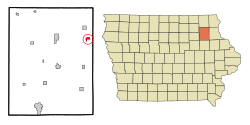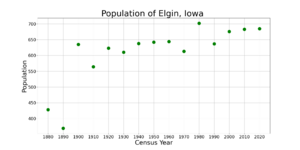Elgin, Iowa facts for kids
Quick facts for kids
Elgin, Iowa
|
|
|---|---|
| Nickname(s):
The Little Switzerland of Iowa
|
|

Location of Elgin, Iowa
|
|
| Country | |
| State | |
| County | Fayette |
| Area | |
| • Total | 0.68 sq mi (1.76 km2) |
| • Land | 0.68 sq mi (1.76 km2) |
| • Water | 0.00 sq mi (0.00 km2) |
| Elevation | 807 ft (246 m) |
| Population
(2020)
|
|
| • Total | 685 |
| • Density | 1,010.32/sq mi (389.88/km2) |
| Time zone | UTC-6 (Central (CST)) |
| • Summer (DST) | UTC-5 (CDT) |
| ZIP code |
52141
|
| Area code(s) | 563 |
| FIPS code | 19-24645 |
| GNIS feature ID | 0456274 |
Elgin is a small city located in Fayette County, Iowa, in the United States. In 2020, about 685 people lived there.
Contents
Where is Elgin, Iowa?
Elgin is located at 42°57′21″N 91°38′11″W / 42.95583°N 91.63639°W. This means it is at 42.955965 degrees north latitude and 91.636394 degrees west longitude. The city sits where Otter Creek flows into the Turkey River. This meeting point of two rivers is called a confluence.
The United States Census Bureau says that Elgin covers about 0.66 square miles (1.71 square kilometers) of land. There is no water area within the city limits.
Elgin's School District
Elgin used to be part of the Valley Community School District. This district also included the nearby towns of Clermont and Wadena.
Because fewer students were enrolling and the state of Iowa was providing less money, the Valley district joined with the North Fayette School district in 2013. The North Fayette district included the towns of West Union, Hawkeye, and Fayette.
The combined district is now called North Fayette Valley. The middle school is in Elgin, and the high school is in West Union. The school's mascot is the Tigerhawks. This name comes from combining the mascots of the two former schools: the Tigers and the Hawks.
| Historical populations | ||
|---|---|---|
| Year | Pop. | ±% |
| 1880 | 428 | — |
| 1890 | 369 | −13.8% |
| 1900 | 635 | +72.1% |
| 1910 | 564 | −11.2% |
| 1920 | 623 | +10.5% |
| 1930 | 610 | −2.1% |
| 1940 | 638 | +4.6% |
| 1950 | 642 | +0.6% |
| 1960 | 644 | +0.3% |
| 1970 | 613 | −4.8% |
| 1980 | 702 | +14.5% |
| 1990 | 637 | −9.3% |
| 2000 | 676 | +6.1% |
| 2010 | 683 | +1.0% |
| 2020 | 685 | +0.3% |
| Source: and Iowa Data Center Source: |
||
Elgin's History
Before settlers arrived, the area around Elgin was home to Sioux and Winnebago Indians. In 1846, after a treaty, these Native American groups were moved by the U.S. military to Minnesota.
In the summer of 1848, many new settlers came to the area. Matthew Conner built a log cabin and a general store. The settlement was first called "Shin Bone Valley." In 1851, a surveyor named M. V. Burdick renamed the town "Elgin." He named it after his hometown, Elgin, Illinois.
Benjamin Dimond became the postmaster in Elgin in 1852. The Burlington, Cedar Rapids and Minnesota Railway arrived in 1872, making it easier to travel and transport goods. The local newspaper, the Elgin Times, started in 1875. Over time, Elgin became a popular place for immigrants from Switzerland to settle.
Who Lives in Elgin?
This section shares information about the people who live in Elgin, based on official counts called censuses.
2020 Census Information
According to the census taken in 2020, there were 685 people living in Elgin. These people lived in 310 households, and 181 of these were families. The city had about 1,010 people per square mile (390 people per square kilometer). There were 341 housing units, which are places where people live.
Most of the people in Elgin (about 95.8%) were White. A small number were Black or African American (0.3%), Native American (0.1%), or Asian (0.3%). About 0.6% were from other races, and 2.9% were from two or more races. About 2.0% of the population identified as Hispanic or Latino.
About 22.9% of households had children under 18 living with them. About 45.2% were married couples living together. The median age in Elgin was 41.3 years old. This means half the people were younger than 41.3, and half were older. About 26.4% of residents were under 20 years old. The population was almost evenly split between males (51.1%) and females (48.9%).
2010 Census Information
In the census of 2010, there were 683 people living in Elgin. There were 318 households and 191 families. The population density was about 1,035 people per square mile (400 people per square kilometer).
Most residents (98.8%) were White. About 0.1% were African American, and 0.4% were Native American. About 1.0% of the population identified as Hispanic or Latino.
About 25.2% of households had children under 18. The average household had 2.15 people, and the average family had 2.75 people. The median age was 43.8 years. About 23.3% of residents were under 18 years old. The population was 49.3% male and 50.7% female.
Education in Elgin
Elgin is part of the North Fayette Valley Community School District. Before July 1, 2018, it was part of the Valley Community School District. That district then merged into the North Fayette Valley district.
See also
 In Spanish: Elgin (Iowa) para niños
In Spanish: Elgin (Iowa) para niños


